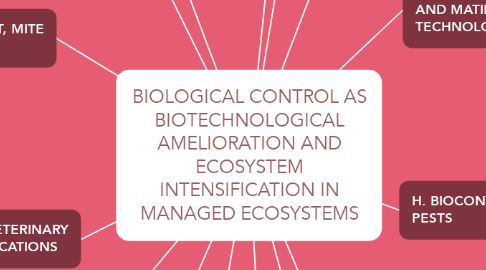BIOLOGICAL CONTROL AS BIOTECHNOLOGICAL AMELIORATION AND ECOSYSTEM INTENSIFICATION IN MANAGED ECOSYSTEMS
by Ibni Hafiz

1. A. INTRODUCTION
1.1. The use of biological agents in pest management for the production of food and fiber for human consumption.
1.2. Predators are pests of livestock, herbivores are pests of crops, parasites and pathogen are pests of livestock or crops.
1.3. Simply living organisms that interfere with the productivity of other living organisms.
2. B. ORGANIC AGRICULTURE
2.1. A system that strives for sustainability, soil fertility, biological diversity and productivity without the use of synthetic herbicides, pesticides etc.
2.2. Relies on fertilizer such as compost, manure and green manure.
2.3. Techniques such as crop rotation and companion planting and stresses biological pest control.
3. E. BIOCONTROL OF INSECT, MITE AND NEMATODE PESTS
3.1. Predators that eat the pests, parasitoids that lay eggs, parasites that debilitate the pests and pathogens that infect and kill their host
3.2. Parasitic wasps are also used as biocontrol agents in orchards. Ageniaspis fuscicollis to control apple ermine moth.
3.3. Nematodes trapping fungi and pathogens that can be coupled with interplantings or mulching with nematodes deterrent plant.
3.4. Insect- specific viruses, have been isolated, evaluated and mass produced.
4. I. BIOCONTROL IN VETERINARY AND MEDICAL APPLICATIONS
4.1. B. thuringiensis ssp. israelensis and Bacillus sphaericus used to control medical pests.
4.2. Can be used with other biocontrol agents such as fungal agents and nematodes.
5. J. BIOCONTROL FOR PROTECTION OF BENEFICIAL ARTHROPODS
5.1. Natural products can be fed to beneficial insects to offer protection from intestinal parasites.
5.2. Managed pollinators have been used to vector against plant pathogens and crop pests.
6. M. NATURAL PRODUCTS, PLANT EXTRACTS, ESSENTIAL OILS, ORGANIC ACIDS HORMONES AND SEMIOCHEMICALS
6.1. Derived from insect, terrestrial plant, microbial and synthetic sources.
6.2. Insect growth disruptors applied to pest insects to interfere their growth and development.
7. O. DRIVERS
7.1. Multinational corporations opposed and denigrated biological control technologies.
7.2. Smaller companies able to provide many different kinds of biological control agents to a growing market.
8. C. BIOCONTROL OF WEEDS
8.1. Insects, fungi, bacteria and virus agents have been develop.
8.2. Cactus moth, Cactoblastis cactorum to control prickly pear cactus.
8.3. Apart from insects, some fungi as 'bioherbicides' can be used.
8.4. Companion plantings simply outcompete weeds by providing ground cover or inhibiting growth and reproduction.
9. D. BIOCONTROL OF PLANT PATHOGENS
9.1. Trichodermal fungal species able to supress soil pathogens such as Fusarium spp. Trichoderma virens for controlling damping off disease of vegetable.
9.2. Applied through formulated sprays or on the bodies of managed pollinators
10. F. BIOCONTROL OF PLANT PATHOGEN AND INSECTS PESTS BY POLLINATOR VECTORS
10.1. Managed pollinators by Pseudomonas fluorescens and Bacillus subtilis against several plant pathogens.
10.2. Formulation of biocontrol agent can be adapted to include bio-insecticidal agent such as spores or toxins of the fungi.
11. G. REPRODUCTIVE STERILITY AND MATING DISRUPTION TECHNOLOGIES
11.1. Rendering one of the sexes reproductively sterile while maintaining their sexual activities.
11.2. Disruption of mating insects by saturating the environment with female mating pheromones.
11.3. Deployed by dispensers within crops to aerial spraying.
12. H. BIOCONTROL OF VETEBRATE PESTS
12.1. Oral contraceptives, administered in baits used to control vertebrates pests. Or immunoconception.
12.2. Providing nesting sites or engaging the services of falconers for birds. Egg oiling, cause the embryo to suffocate.
12.3. Barn owls to control rats in oil palm plantations.
13. K. PRODUCTION, DEPLOYMENT AND ESTABLISHMENT OF BIOCONTROL AGENTS
13.1. Requires enough agents to be introduced into the environment and to be effective.
13.2. Subjected to screening for host specificity, efficacy and environmental concerns.
13.3. Biological control agents that established in the pests environment, they are applied as needed referred to as inundative biological control.
14. L. GENETIC ENGINEERING
14.1. To overcome the defense mechanism that have evolved in the pest.
15. N. ECOLOGICAL CONSIDERATIONS
15.1. Autecological approaches intrinsic to the use of natural products and sexual sterility
15.2. Pairwise biocontrol agents vs pests method including genetic modifications.
15.3. Application of multi-species, multi-trophic and multi-disciplinary biocomplexity.


